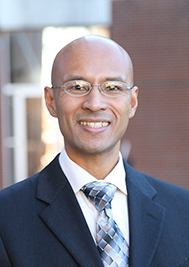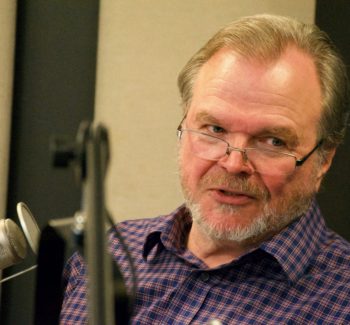“Spooky Action at a Distance” Makes Sense—in the Quantum World
Einstein never liked quantum mechanics but each transistor in your cell phone is a quantum deviceIn last week’s podcast, “Enrique Blair on quantum computing,” Walter Bradley Center director Robert J. Marks talks with fellow computer engineer Enrique Blair about why quantum mechanics is so strange. The discussion turned to why Albert Einstein, a brilliant but orderly mathematical thinker, did not really like quantum mechanics at all and what we should learn from that:
The discussion of Einstein and “spooky action at a distance” (his way of describing quantum particles’ behavior) starts at approximately 27:45. The Show Notes and transcript follow.
Excerpts from the transcript:
Robert J. Marks: Albert Einstein didn’t like quantum mechanics or certain aspects of quantum mechanics. Dd he die thinking that quantum mechanics was a fluke?

Enrique Blair (pictured): That’s an interesting question because Einstein’s work was integral to the formulation of quantum mechanics. But he was uncomfortable with a couple of parts of it. He did not like the probabilistic interpretation of quantum mechanics so much. He wanted something that was much more deterministic.
Note: Much has been written about the decades-long debate between Einstein and the quantum physicists over whether “spooky action at a distance” (quantum uncertainty—remember Schrödinger’s dead-and-alive cat?) could be part of a final theory in physics. John Bell (1928–1990), a physicist working at CERN, very much wanted to provide evidence for Einstein’s view. But he ended up demonstrating that the spooky action is real, at least for photons. The determinism—where things happen only according to predictable laws—that Einstein was seeking wasn’t there.
Enrique Blair: The second thing he was just not comfortable with was a concept called nonlocality in quantum mechanics. You can entangle multiple quantum systems. Entanglement means that each subsystem no longer has its own local quantum state. That means that we can’t understand its quantum state completely in a local sense.
The quantum state has to be understood in terms of the other systems with which it’s entangled. Now this has some really interesting ramifications. If you entangle a couple of systems like qubits—quantum bits that are zero or one or some superposition— and then you separate them at a vast distance, you can conduct operations on one qubit that affect the state of the other qubit that’s very, very far away. Einstein did not like this at all. He called that “spooky action at a distance.”
Robert J. Marks: Yeah. And the weird thing, as I recall, is that the collapse of this entanglement on one end immediately caused the collapse on the other end, faster than the speed of light.
Enrique Blair: That’s right. You can have a vast separation between these two particles and the instant that Alice takes a measurement on one particle, it immediately affects the state of Bob’s entangled qubit too. And it doesn’t matter how far these things are separated.
Note: Nonlocality: “the apparent ability of objects to instantaneously know about each other’s state, even when separated by large distances (potentially even billions of light years), almost as if the universe at large instantaneously arranges its particles in anticipation of future events” – Physics of the Universe
Qubits “the symbols are both 0 and 1 (and all points in between) at the same time” – How Stuff Works
Quantum entanglement: “particles can remain connected such that the physical properties of one will affect the other, no matter the distance (even miles) between them” – LiveScience
Recently, visual evidence for entanglement has emerged:
For the first time ever, physicists have managed to take a photo of a strong form of quantum entanglement called Bell entanglement—capturing visual evidence of an elusive phenomenon which a baffled Albert Einstein once called ‘spooky action at a distance’.
Two particles which interact with each other—like two photons passing through a beam splitter, for example—can sometimes remain connected, instantaneously sharing their physical states no matter how great the distance which separates them. This connection is known as quantum entanglement, and it underpins the field of quantum mechanics.
University of Glasgow, “Scientists unveil the first-ever image of quantum entanglement” at Phys.org (July 13, 2019) Open access paper.
Robert J. Marks: What are some of the places that quantum mechanics is used?
Enrique Blair: Oh well, in terms of human users, we use it all the time. You might even say everybody’s an expert at it, even children. We’re talking electronic devices… smart watches, cell phones, laptops and super computers. All of these have multitudes of transistors used for classical information processing, yet each transistor in itself is a quantum device. It uses quantum mechanics to operate. Quantum mechanics is in the operating principles of these devices.
But we have to point out that we’re still processing bits in a classical way. That is, we’re using ones and zeros. We’re not yet using quantum bits, these superpositions of ones and zeros.

Robert J. Marks (pictured): Engineers are people that take science and reduce it to practice. Some of things that you mentioned are examples of reduction of things to practice which use quantum computing. What are some of the things that you’re looking at with the application of quantum mechanics?
Enrique Blair: I’m really working on two different areas. My first area is molecular computing. Quantum mechanics governs the operation of these molecular computing devices, but we want to process classical information. We believe these molecules could operate at speeds thousands of times faster than the transistors we’re using today.
That would be really helpful for humanity in terms of reducing power consumption. Because really, the cost of computing in terms of global power production is pretty big. I mean, I know that in 2010, it was estimated to be about 10% of global power.
Robert J. Marks: Say that again. 10% of global power is used for computers?
Enrique Blair: We’ve had this boom of cryptocurrencies, and our world is much more connected now and people want the Internet of Things. So we really need to find ways to reduce power consumption in our devices.
It’s well known that we’re running out of room on the road map for scaling down our semiconductors. That’s why I’m interested in new devices that depart from the transistor paradigm.
Note: Bitcoin mining, for example, uses a great deal of energy via conventional computer calculations. “The software that mines bitcoin is designed so that it always will take 10 minutes for everyone on the network to solve the puzzle… As more people join the bitcoin network and try to mine bitcoins, the puzzles become harder, and more computing power and electricity are used for each bitcoin produced.” – the balance By lowering the energy budget of computers, quantum computing could reduce cryptocurrencies’ environment impact, as well as that of many other automated processes.
Next: What quantum computing can and can’t do for us in the macro world
Here are the earlier discussions:
The final ambiguous truth about Schrödinger’s cat. Schrödinger came up with the cat illustration to explain quantum mechanics to interested people who were not physicists. We don’t see quantum paradoxes outside the lab because everything we see consists of far too many quantum subsystems for any one particle to stand out.
How scientists have learned to work with the quantum world.
It’s still pretty weird, though. Wave function mathematics can work with particles that may be in different places (quantum superposition). QM can also generate truly random numbers we can use.
and
Here’s why the quantum world is just so strange. It underlies our universe but it follows its own “rules,” which don’t make sense to the rest of us. Computer engineer Enrique Blair explains to Robert J. Marks the simple experiment that shows why so many scientists find the quantum world “mind-blowing.”
Show Notes
- 00:54 | Introducing Dr. Enrique Blair, a professor of electrical and computer engineering at Baylor University
- 03:08 | The history of quantum mechanics
- 13:16 | Quantum superposition
- 21:50 | Schrödinger’s cat
- 27:45 | Why didn’t Einstein like quantum mechanics?
- 28:51 | Quantum entanglement
- 32:58 | Applications of quantum mechanics
- 34:53 | Quantum dots
- 37:31 | Quantum computing
- 43:48 | The use of quantum computers
- 47:55 | Quantum supremacy
- 55:32 | Quantum communication
- 58:47 | The future of quantum computing
Additional Resources
- Enrique Blair’s website
- Copenhagen Interpretation of Quantum Mechanics at Standford Encyclopedia of Philosophy
- Young’s double-slit experiment at Encyclopædia Britannica
- Planck’s explanation of black-body radiation at Encyclopædia Britannica
- Quantum superposition at Wikipedia
- Nobel Prize in Physics 1932 — Werner Heisenberg
- Nobel Prize in Physics 1933 — Erwin Schrödinger
- Many-Worlds Interpretation of Quantum Mechanics at Stanford Encyclopedia of Philosophy
- Schrödinger’s cat at Wikipedia
- Quantum entanglement at Wikipedia
- Quantum bit (qubit) at Wikipedia
- Quantum dots at Wikipedia
- Shor’s algorithm at Wikipedia
- RSA at Wikipedia
- Grover’s algorithm at Wikipedia
- Quantum supremacy at Wikipedia
- IBM on Google’s claim of quantum supremacy
- Quantum communication at MIT Technology Review
- Adiabatic quantum computation at Wikipedia
